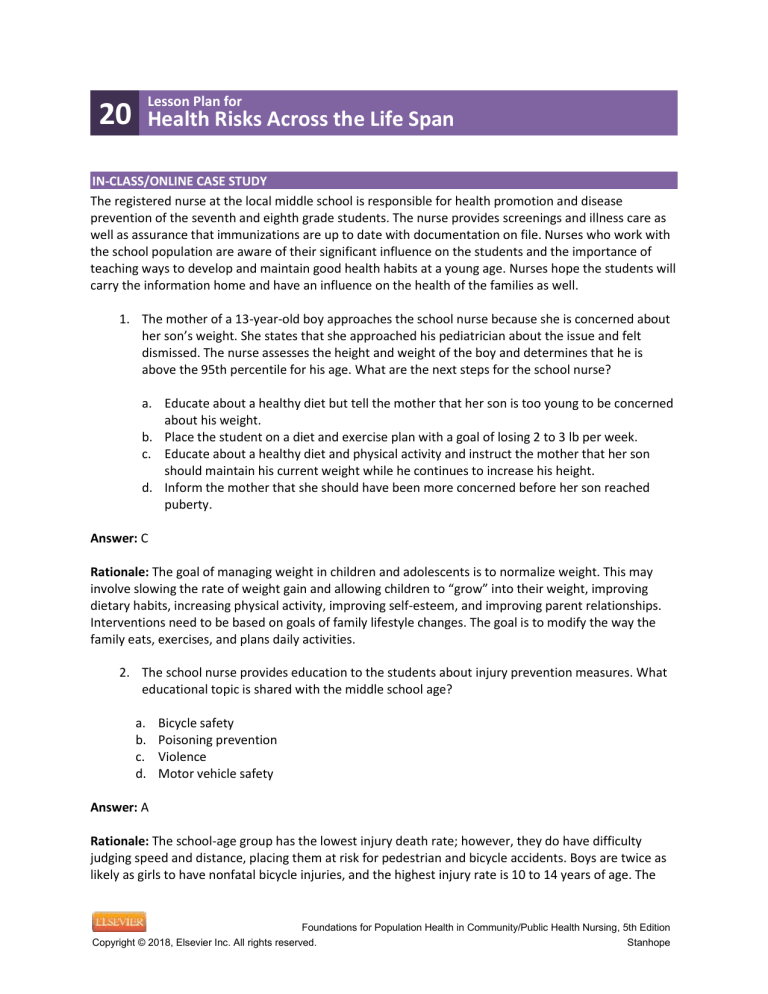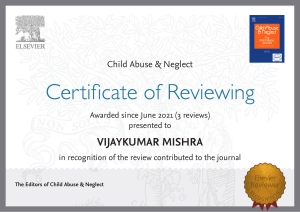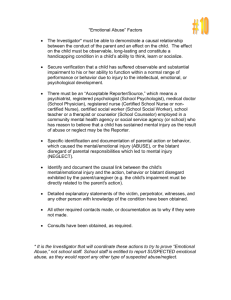
Lesson Plan for 20 Health Risks Across the Life Span IN-CLASS/ONLINE CASE STUDY The registered nurse at the local middle school is responsible for health promotion and disease prevention of the seventh and eighth grade students. The nurse provides screenings and illness care as well as assurance that immunizations are up to date with documentation on file. Nurses who work with the school population are aware of their significant influence on the students and the importance of teaching ways to develop and maintain good health habits at a young age. Nurses hope the students will carry the information home and have an influence on the health of the families as well. 1. The mother of a 13-year-old boy approaches the school nurse because she is concerned about her son’s weight. She states that she approached his pediatrician about the issue and felt dismissed. The nurse assesses the height and weight of the boy and determines that he is above the 95th percentile for his age. What are the next steps for the school nurse? a. Educate about a healthy diet but tell the mother that her son is too young to be concerned about his weight. b. Place the student on a diet and exercise plan with a goal of losing 2 to 3 lb per week. c. Educate about a healthy diet and physical activity and instruct the mother that her son should maintain his current weight while he continues to increase his height. d. Inform the mother that she should have been more concerned before her son reached puberty. Answer: C Rationale: The goal of managing weight in children and adolescents is to normalize weight. This may involve slowing the rate of weight gain and allowing children to “grow” into their weight, improving dietary habits, increasing physical activity, improving self-esteem, and improving parent relationships. Interventions need to be based on goals of family lifestyle changes. The goal is to modify the way the family eats, exercises, and plans daily activities. 2. The school nurse provides education to the students about injury prevention measures. What educational topic is shared with the middle school age? a. b. c. d. Bicycle safety Poisoning prevention Violence Motor vehicle safety Answer: A Rationale: The school-age group has the lowest injury death rate; however, they do have difficulty judging speed and distance, placing them at risk for pedestrian and bicycle accidents. Boys are twice as likely as girls to have nonfatal bicycle injuries, and the highest injury rate is 10 to 14 years of age. The Foundations for Population Health in Community/Public Health Nursing, 5th Edition Copyright © 2018, Elsevier Inc. All rights reserved. Stanhope 2 Chapter 20Health Risks Across the Life Span ___________________________________________________ use of bicycle helmets would prevent deaths. Peer pressure often inhibits the use of protective devices such as helmets and limb pads. 3. A student presents to the nurses’ office with a severe allergic reaction to a bee sting. What is the primary role of the nurse in delivering emergent care to the child? a. b. c. d. Call the parents to obtain phone consent for treatment. Provide emergency care and then inform the parents. Call the child’s primary care physician to obtain orders. Send the student to the nearest emergency department. Answer: B Rationale: Most states have enacted laws allowing health care providers to treat adolescents in certain situations without parental consent. These include emergency care, substance abuse, pregnancy, and birth control. All 50 states recognize the “mature minors doctrine.” This allows youths 15 years of age and older to give informed medical consent if it is apparent that they are capable of understanding the risks and benefits and if the procedure is medically indicated. In this case, the school nurse should provide care to treat the emergent situation while informing the parents as soon as possible. 4. A parent who fails to ensure that their child attends school is exhibiting a. b. c. d. acts of commission. psychological abuse. acts of demission. acts of omission. Answer: D Rationale: Child maltreatment is defined as any act or series of acts of commission or omission by an adult that results in harm, potential for harm, or threat of harm to a child. Acts of commission (abuse) include physical abuse, sexual abuse, and psychological abuse; acts of omission (neglect) include failure to provide (e.g., physical neglect, emotional neglect, medical or dental neglect, educational neglect) and failure to supervise (e.g., inadequate supervision, exposure to violent environments). Foundations for Population Health in Community/Public Health Nursing, 5th Edition Copyright © 2018, Elsevier Inc. All rights reserved. Stanhope



